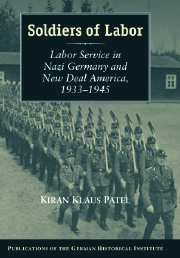Book contents
- Frontmatter
- Introduction
- 1 A Panacea for the Great Depression? Labor Service Ideas and Their Implementation Prior to 1933
- 2 Service to the Community: The Organization of the Labor Services
- 3 “Citizens,” Volksgenossen, and Soldiers: Education in the Labor Services
- 4 In “The Grandeurs of Nature”: The Work of the Labor Services
- Concluding Reflections
- Abbreviations
- Sources and Bibliography
- Index
4 - In “The Grandeurs of Nature”: The Work of the Labor Services
Published online by Cambridge University Press: 05 January 2013
- Frontmatter
- Introduction
- 1 A Panacea for the Great Depression? Labor Service Ideas and Their Implementation Prior to 1933
- 2 Service to the Community: The Organization of the Labor Services
- 3 “Citizens,” Volksgenossen, and Soldiers: Education in the Labor Services
- 4 In “The Grandeurs of Nature”: The Work of the Labor Services
- Concluding Reflections
- Abbreviations
- Sources and Bibliography
- Index
Summary
There were numerous similarities in the work undertaken by the RAD and the CCC. Forestry and soil improvement projects made up a substantial share of the work on either side of the Atlantic, and in both countries the labor service was also used for disaster relief and cultural projects. What varied was the significance that was officially accorded to these activities. While practical work was the chief mission of the CCC, in Germany it was subordinated to the educational goal of the service. Still, even in the RAD, according to Hierl, “work on the German person” was joined by “work on the German soil.”
Historians have paid virtually no attention to the latter, which is especially striking since work accounted for the largest single block of service hours. I begin this chapter by analyzing work in the German Labor Service with respect to the areas of activity, planning, the notion of work and its implementation at the job sites; this is followed by a look at CCC projects and a comparative assessment. In the final analysis, my intent is to juxtapose the effectiveness and efficiency of the two services with regard to their work projects. Unfortunately, neither effectiveness nor efficiency can be precisely determined for either the RAD or the CCC, since conditions in the more than one-thousand camps were too varied over the years. Because of the nature of the statistical material, it is impossible even to indicate the total work output for each of the two services.
- Type
- Chapter
- Information
- Soldiers of LaborLabor Service in Nazi Germany and New Deal America, 1933–1945, pp. 292 - 394Publisher: Cambridge University PressPrint publication year: 2005



